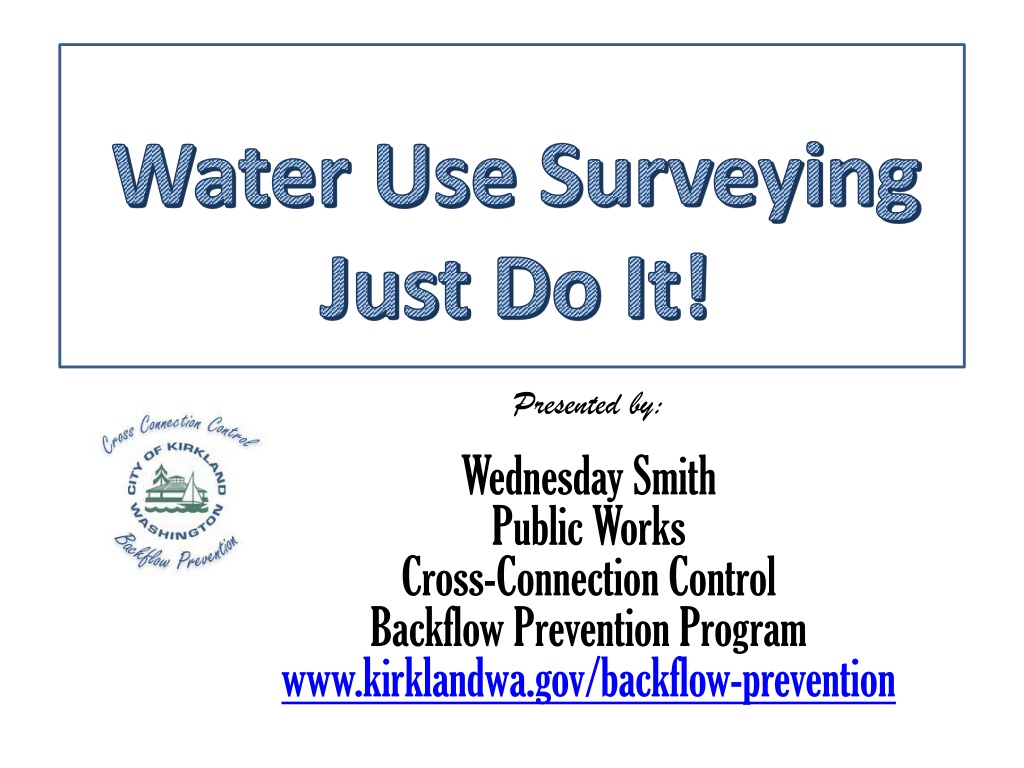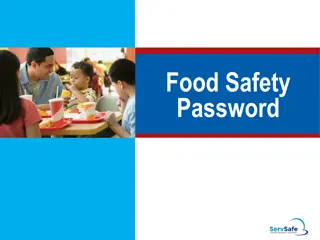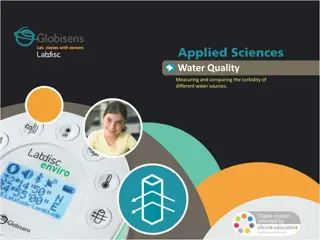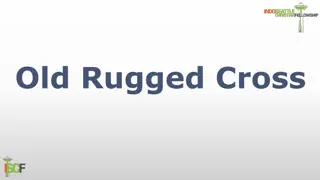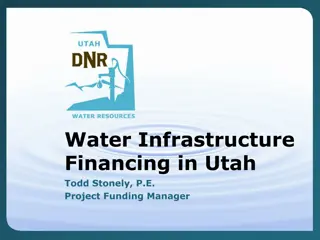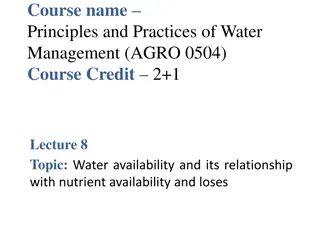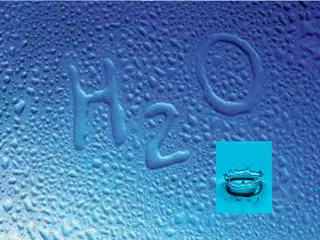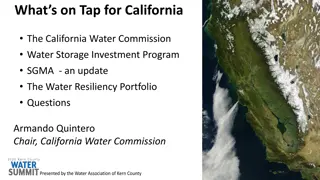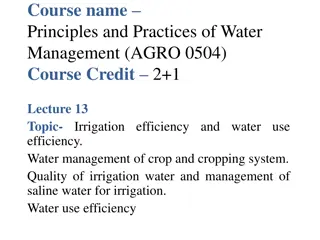Understanding Cross-Connection Control and Backflow Prevention in Water Systems
A cross-connection is a physical link between potable water sources and contaminants, posing health risks. Cross-Connection Control Specialists (CCS) play vital roles in assessing hazards, choosing backflow protection methods, inspecting installations, and maintaining records to safeguard public water quality. Discover the importance of detecting and preventing cross-connections for water safety.
Download Presentation

Please find below an Image/Link to download the presentation.
The content on the website is provided AS IS for your information and personal use only. It may not be sold, licensed, or shared on other websites without obtaining consent from the author. Download presentation by click this link. If you encounter any issues during the download, it is possible that the publisher has removed the file from their server.
E N D
Presentation Transcript
Water Use Surveying Just Do It! Presented by: Wednesday Smith Public Works Cross-Connection Control Backflow Prevention Program www.kirklandwa.gov/backflow-prevention
Just Do It! Art Williams Art Williams
Durango CO 2014 Redmond WA 2016 City of Kirkland 2020 ABOUT ME Current Certifications: WA DOH Water Distribution Manager 2 (WDM2) Cross Connection Control Specialist (CCS) Backflow Assembly Tester (BAT) Backflow Assembly Specialty Plumber License (PL30) IAPMO ASSE INTERNATIONAL (International Association of Plumbing and Mechanical Officials & American Society of Sanitary Engineering) Backflow Prevention Program Administrator Cross-Connection Control Surveyor Backflow Prevention Assembly Tester
A cross connection is a physical connection between a potable (drinkable) water supply and a source of contamination or pollution. This connection can be created when plumbing is installed, when using certain appliances, or even simply by attaching a hose to a faucet. WHAT IS A CROSS CONNECTION? Cross connections are not easy to discover but can pose a serious health hazard and threat to water quality.
Duties of a CCS WAC 246-292-033 (1) A CCS designated by a purveyor as required in WAC 246-292-050(4) shall develop, implement, and maintain a cross-connection control program that meets the requirements in WAC 246-290-490. (2) A CCS shall perform the following duties: (a) Assess the degree of hazard posed by the consumer's water system to the public water system, as required in WAC 246-290-490 (4)(a)(i); (b) Determine the appropriate method of backflow protection to prevent contamination of the public water system by the consumer's water system, as required in WAC 246-290-490 (4)(a)(ii); (c) Inspect backflow preventer installations to verify that the protection provided is appropriate for the assessed degree of hazard, as required in WAC 246-290-490 (7)(a)(i); (d) Investigate and respond to backflow incidents known to have contaminated or suspected of contaminating the public water system, as required in WAC 246-290-490 (3)(h); (e) Develop and maintain the purveyor's cross-connection control records, as required in WAC 246-290-490 (3), (4), and (8); (f) Complete and sign the purveyor's cross-connection control related reports and make the reports available to the department upon request, as required in WAC 246-290-490(8) including: (i) The cross-connection control annual summary reports; and (ii) Backflow incident reports after an incident has occurred that contaminated the public water system; (g) Take corrective action as required in WAC 246-290-490 (2)(h) when a consumer fails to comply with the purveyor s cross-connection control requirements regarding the installation, inspection, field testing, maintenance, or repair of a backflow preventer that protects the public water system; and (4) As allowed in WAC 246-290-490 (7)(a)(ii), a CCS's duties may include inspecting: (b) Backflow prevention assemblies to determine if they are installed correctly and approved by the department.
High Health Hazards Any substance that if introduced to the public water system could cause serious illness, death or could spread diseases. What kind of hazards are there? Low Health Hazards Any substance that if introduced to the public water supply would not be a health hazard but would constitute a nuisance or be aesthetically objectionable.
What do we do to protect our drinking water? Assess the degree of hazard posed by the consumer s water system. Table 12 in the Washington Administrative Codes (WAC) helps determine the appropriate method of backflow prevention. WAC 246-290-490 Cross Connection Control Table 12 (Previously Table 8) Appropriate Methods of Backflow Protection for Premises Isolation **RPBA Reduced Pressure Backflow Assembly, RPDA Reduced Pressure Detector Assembly, DCVA Double Check Valve Assembly, DCDA Double Check Detector Assembly Degree of Hazard Application Condition Appropriate Approved Backflow Preventer High health cross-connection hazard Backsiphonage or backpressure backflow Air Gap, RPBA**, or RPDA** Low cross-connection hazard Backsiphonage or backpressure backflow Air Gap, RPBA**, RPDA**, DCVA**, or DCDA** (i) The purveyor shall ensure that an approved air gap, RPBA, or RPDA is installed for premises isolation for service connections to premises posing a high health cross-connection hazard including, but not limited to, those premises listed in Table 13 (next page).
WAC 246 WAC 246- -290 290- -490 Cross Connection Control 490 Cross Connection Control Severe and High Health Cross-Connection Hazard Premises Requiring Premise Isolation by Air Gap (AG) or Reduced Pressure Backflow Assembly (RPBA) TABLE 13 (Previously Table 9) RP Models Agricultural (farms and dairies) Beverage bottling plants Car washes Chemical plants Min. 1 Commercial laundries and dry cleaners Air Gap Premises where both reclaimed water and potable water are provided Film processing facilities Food processing plants Hospitals, medical centers, nursing homes, veterinary, medical and dental clinics, and blood plasma centers Premises with separate irrigation systems using the purveyor's water supply and with chemical addition+ Laboratories Metal plating industries Mortuaries Petroleum processing or storage plants Piers and docks Radioactive material processing plants or nuclear reactors* Survey access denied or restricted Wastewater lift stations and pumping stations Wastewater treatment plants* Premises with an unapproved auxiliary water supply interconnected with the potable water supply
Backflow prevention assemblies are critical components that protect the potable water systems from pollution or contamination sources. It is important to remember a backflow preventer is a mechanical device which requires testing and at some point, in time will require replacement or repair. Backflow Assemblies Clearance and Accessibility Requirements Uniform Plumbing Code (UPC) 603.4.3 Access and Clearance: Access and clearance shall be provided for the required testing, maintenance, and repair.
WA DOH (b) The purveyor shall ensure that approved backflow preventers are installed in a manner that: (i) Facilitates their proper operation, maintenance, inspection, in-line testing, and repair using standard installation procedures acceptable to the department such as those in the USC Manual or PNWS- AWWA Manual;
Hose Bib Backflow protection All newer homes have hose bibs that have an internal atmospheric vacuum breaker (AVB) built in. But in older homes they do not have any protection. A simple hose bib vacuum breaker adapter is an easy solution for those who want to use a hose. AVB s are designed with a disk that seals against the diaphragm which closes the check allowing the operating vent ports open. Facts you should know about an AVB: The AVB is a non-testable device and cannot be under continuous pressure, as the poppet would likely stick and the AVB would no longer function properly. Shutoff or control valves should never be placed downstream, as this could result in continuous pressure (12 hours of more) on the AVB. (i.e. spray nozzles, adapters, timer. ) If the device begins to leak it needs repaired or replaced.
Cross-Connection Water Use Survey Program Information Site Survey Process
AUTHORITY WAC 246-290-490 3(b) Element 1: The purveyor shall adopt a local ordinance, resolution, code, bylaw, or other written legal instrument that: (i) Establishes the purveyor's legal authority to implement a cross connection control program (ii) Describes the operating policies and technical provisions of the purveyor s cross-connection control program; and (iii) Describes the corrective actions used to ensure that consumers comply with the purveyor s cross connection control requirements. (c) Element 2: The purveyor shall develop and implement procedures and schedules for evaluating new and existing service connections to assess the degree of hazard posed by the consumer s premises to the purveyor s distribution system and notifying the consumer within a reasonable time frame of the hazard evaluation results. At a minimum, the program shall meet the following: (ii) For all other connections, procedures shall ensure that an initial evaluation is conducted in accordance with a schedule acceptable to the department and (i) For connections made on or after April 9, 1999, procedures shall ensure that an initial evaluation is conducted before water service is provided (iii) For all service connections, once an initial evaluation has been conducted, procedures shall ensure that periodic reevaluations are conducted in accordance with a schedule acceptable to the department and whenever there is a change in the use of the premises.
WORKING WITH THE AHJ WAC 246-290-490 2(d) The purveyor shall coordinate with the authority having jurisdiction in all matters concerning cross connection control. The purveyor shall document and describe the coordination, including delineation of responsibilities, in the written cross connection control program in the written cross connection control program required in (e) of this subsection. (e) Under this section, purveyors are not responsible for eliminating or controlling cross connections within the consumer's water system. Under chapter 19.27 RCW, the responsibility for cross connection control within the consumer s water system, i.e., within the property lines of the consumer s premises, lies with the authority having jurisdiction. COK Authority The authority for the City of Kirkland s Cross Connection Control Program is derived from Chapter 603.0 of the Uniform Plumbing Code (UPC) including its Washington State Amendments as adopted by Kirkland Municipal Code 21.24.010. The UPC refers to WAC 246-290-490 and to the Washington State Department of Health regulations including the AWWA (American Water Works Association) Pacific Northwest Section s of Accepted Procedure and Practice in Cross Connection Control Manual. City of Kirkland Authority and Municipal Code:
Getting Started 1) Obtain an active service connection list; (Meter information from finance). 2) Ensure you have a good tracking system of sites surveyed Excel is a good tool if you do not have a software tracking program. You can keep annual data to see running totals. Include in your tracking: i. Acct# ii. Device/Assembly# iii. Business Name iv. Business Owner v. Contact First and Last Name vi. Physical Address vii.Type of Assemblies Installed if any viii.Hazard ix. Is it Premise or In-Premise? x. Make, Model, SN, and Size of Assembly xi. Date Surveyed xii.Compliant Yes or No xiii.Comments xiv.Follow up date xv.Final Compliant Yes or No xvi.# Of corrections xvii.Date Completed Excel Tracking
PREPARATION IS THE KEY (1) Verify Site Location look for the number of buildings and any other meters served on site. a. Map it out (GIS, Google) b. Can you find the meter? c. Get as much information you can and make notes on what you see. (2) Using you finance system or list provided to verify meter information Manufacture, Size, Location, service addresses, owner information, tenant information especially for multi commercial sites.
Notification of Water Use Survey 1) Notification of Water Use Survey a. The initial letter needs to explain what you are asking for and why and should include: EXAMPLE i. State Requirement Found in PNWS AWWA, WAC 246-290-490 Element #4 ii. City Code Requirement and Responsibility iii.How long this survey will take. iv.Piping plans if available v. Who they should to contact for more details? vi.Follow up date or Appointment Details You should require a confirmation of appointment to ensure contact has been made. b. Keep a copy of the letter to take with you. (People like to claim they did not receive it and were not notified.) c. Save it in a format you can easily track i. Example: Acct# Business Name Type of Letter 4140-09500 CHAINLINE BREWING WATER USE SURVEY NOTIFICATION LETTER 4140-09500 CHAINLINE BREWING WATER USE SURVEY APPOINTMENT LETTER 4140-09500 CHAINLINE BREWING WATER USE SURVEY POST SURVEY LETTER OF COMPLIANCE 4140-09500 CHAINLINE BREWING WATER USE SURVEY POST SURVEY LETTER OF NON-COMPLIANCE
BE PREPARED: Tips For Being Ready You may need to follow up if you have not received a confirmation of appointment. Confirming Appointment: It s a great idea to get the full name and phone number of person you are meeting and set up your meeting location. Make sure you request a person who is familiar with the facility, plumbing system, and equipment processes. Explain what they should expect from this survey. Take a copy of the appointment letter with you
Preparing Your Water Use Survey Form Prepare your survey form in advance. There are many types of forms available. You can use one already provided by USC Manual Cross-Connection Control, IAPMO, electronic survey systems, or create your own. COK Example Commercial IAPMO Example USC Example COK Survey Example-Residential
Tools and Resources Tools Bring a flashlight, clipboard, forms, soap stone (for revealing SN on assemblies), small and long screwdriver for opening lids, gloves, face masks (medical facilities) and camera. NOTE: Photos should include assembly installation, assembly name plate (make model & SN), water using equipment including model information for equipment you are not familiar with. This will also you to research the item to see if additional protection is needed. Resources You should have reference materials with you. Examples include: i. List of Table 13 ii. List of Fixture isolations Hazards 1. PNWS AWWA Cross-Connection Control Manual a. Page 168 Chapter 5 iii.Janitors sink protection information - Mop Sink Best Practices iv.Chemical Dispenser & AVB use information v. Installation standards (spec sheets)
Rule #1 is to take your time. We are protecting public health. If the time is not convenient or you feel you are being rushed around, reschedule the appointment. It s important to do a thorough survey! You should always begin your survey at the meter. This will allow you to verify the meter serial number and installation of any backflows for premise including dedicated irrigation lines. You may find more than one meter. Document everything you see including the condition of the meter. It s also best to allow the person you are walking with to determine the route of the survey for larger complexes. They have the most knowledge of how the property is set up. Before you begin your survey, go through your form and explain to them what you are looking for and you may be asking the same questions multiple times depending on how many buildings your visiting. Have one form per building or business so you can keep everything separate by meter and organized.
Performing Water Use Survey Continued What you need to know? How is the water being used? Do they have existing protection? What other water using equipment do they have that was not asked on the form? Verify contact person, mailing address and follow up phone number. You may need to get on a dirty floor, behind a hot oven, or under a sink to verify the make, model and serial number so be prepared. It s best to have two people during a survey but it okay if you do not. If you are the only one with the customer, talk them through the process as you tour the facility. Help educate them during the survey so if you find compliance issues, they will be able to understand what needs to be done before they receive the post survey letter. Note: If you have a difficult customer, less may be better. Be ready, some folks don t care and don t want to be educated. Take pictures of everything and make sure you have your photos dated (public records request). Finally, be sure to thank them for their time and give them a time frame on your follow up and post survey letter.
POST SURVEY Document your tracking log, database, and files Save site pictures with details (Device# Hazard SN., etc.) Link Prepare compliance letter; Owner and tenant Link a. Include: i. Photos if possible (Make is simple) ii.CC: all who need to know. 1.Public Works Manager 2.AHJ Planning & Development 3.Inspector 4.Owner/Tenant Set up a tracking system by date for easy access and follow up. Example: tickler file, calendar appointment etc.
WHAT YOU MAY FIND IMPROPER INSTALLATIONS
Domestic Backflow Improper Install (Unapproved Assembly): Before Correction
Domestic Backflow Proper Install (Approved Assembly): After Correction The Double Check Valve Assembly (DCVA) is an approved backflow assembly consisting of two single check valves assembled within one body and furnished with four test cocks and two shut-off valves.
Domestic Backflow Improper Install (Unapproved Assembly): Before Correction
Domestic Backflow Proper Install: After Correction
Unprotected By-Pass Domestic Water By-Pass without backflow protection Correction: Removed and capped
Dock Water (Table 13) Severe High Health Hazard
RPBA installed behind beverage dispenser hoses making testing & repair difficult.
Support stand installed over assembly access requiring removal for repair
Installation over 5 without permanent platform for testing and repairs
SVB (Spill Resistant Vacuum Breaker) Installation Over 5 To test a SVB a tester is required to removed the Bonnet (Cap) and visually verify the water has drained and the air inlet fully opened.
Application: Hood Scrubber Hazard: High Health Hazard Installation Issues: UPC 603.4.9 Prohibited Location. Backflow prevention devices with atmospheric vents or ports shall not be installed in pits, underground or in submerged locations. Backflow preventers shall not be located in any area containing fumes or aerosols that are toxic, poisonous, infectious, or corrosive.
Chemical Container Resting & Leaking on assembly
RPBAs without 12 Relief Valve Clearance
Chemical Dispensers All Chemical Dispensers with a ASSE 1055B have internal air gaps and meet backflow prevention requirements. The system will show an approval with ASSE 1055B label or engraving. If the system does not show a label then protection is required with an RPBA or SVB.
Janitor Closets with Chemical Dispensers Protection Type: RPBA Protection Type: SVB Requires installation 12 Above Use
Irrigation Systems: Improper Installations Buried in dirt & mud with test port caps missing (cross-connection)
QUESTIONS???? For more details on our Backflow Prevention Program, please call us at 425-587-3913 or visit our new web page at: www.kirklandwa.gov/backflow-prevention
